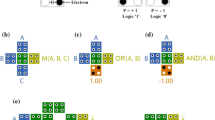Abstract
Redundant binary number appears to be appropriate for high-speed arithmetic operation, but the delay and hardware cost associated with the conversion from redundant binary (RB) to natural binary (NB) number is still a challenging task. In the present investigation a simple approach has been adopted to achieve high speed with lesser hardware and power saving. A circuit level approach has been adopted to implement the equivalent bit conversion algorithm (EBCA) (Kim et al. IEEE Journal of Solid State Circuits 36:1538-1544, 2001, 38:159-160, 2003) for RB to NB conversion. The circuit is designed based on exploration of predictable carry out feature of EBCA algorithm. This implementation concludes a significant delay power product and component complexity advantage for a 64-bit RB to NB conversion using novel carry-look-ahead equivalent bit converter.













Similar content being viewed by others
References
Takagi, N., Yasuura, H., & Yajima, S. (1984). A VLSI-Oriented High-Speed Multiplier Using Redundant Binary Adder Tree. IECE Japan, J66.d, 683–690.
Takagi, N., Yasura, H., & Yajima, S. (1985). High-speed VLSI multiplication algorithm with a redundant binary addition tree. IEEE Transactions on Computers, C-34(9), 217–220.
Ercegovac, M. D., & Lang, T. (1987). On-the-fly conversion of redundant into conventional representations. IEEE Transactions on Computers, C-36(7), 895–897.
Rajashekhara, T. N., & Nale, A. S. (1990). Conversion from signed-digit to radix complement representation. International Journal of Electronics, 69(6), 717–721.
Yen, S., Laih, C., Chcn, C., & Lee, J. (1992). An efficient redundant-binary number to binary number converter. IEEE Journal of Solid-state Circuits, 27(1), 109–112.
Bewick, G. (1994). “Fast multiplication: algorithms and implementations,” Technical report CSL-TR-94-617, Stanford Univ., Apr.
Choo, I., & Deshmukh, R. G. (2001). “A novel conversion scheme from a redundant binary to two’s complement binary number for parallel architectures,” in Southeastcon 2001 Proceedings of IEEE, 2001, Clemson, pp. 196–201, March 30–April 1.
Blair, G. M. (1998). The Equivalence of two’s-complement addition and the conversion of redundant binary of twos-complement numbers. IEEE Transactions on Circuits and Systems I: Fundamental Theory and Applications, 45(6), 669–671.
Ruiz, G. A. (1999). 4bit CLA-based conversion from redundant to binary representation for CMOS simple and multi-output implementations. Electronics Letters, 35(4), 281–283.
Lee, S.-H., Bae, S.-J., & Park, H.-J. (2002). A compact radix-64 54x54 CMOS redundant binary parallel multiplier. IEICE Transactions on Electronics, E85-C(6), 1342–1350.
Kim, Y., Song, B.-S., Grosspietsch, J., & Gilling, S. F. (2001). A carry-free 54b x 54b multiplier using equivalent bit conversion algorithm. IEEE Journal of Solid State Circuits, 36(10), 1538–1544.
Kim, Y., Song, B.-S., Grosspietsch, J., & Gilling, S. F. (2003). Correction to a carry-free 54 b X 54 b multiplier using equivalent bit conversion algorithm. IEEE Journal of Solid-State Circuits, 38(1), 159–160.
Avizienis, A. (1961). IRE Transactions on Electronics Computers, EC-10, 389–400.
Makino, H., Nakase, Y., Suzuki, H., Morinaka, H., Shinohara, H., & Mashiko, K. (1996). An 8.8-ns 54 x 54-Bit multiplier with high speed redundant binary architecture. IEEE Journal of Solid State Circuits, 31(6), 773–783.
Booth, A. D. (1951). A signed binary multiplication technique. Quarterly Journal of Mechanics and Applied Mathematics, 4(2), 236–240.
Goto, G., Inoue, A., Ohe, R., Kashiwakura, S., Mitarai, S., Tsuru, T., et al. (1997). A 4.1 ns compact 54X54 -bit multiplier utilizing sign-select Booth encoders. IEEE Journal of Solid-State Circuits, 32(11), 1676–1682.
Hennesy, J. L., & Patterson, D. A. (2000). Computer architecture a quantitative approach. Morgan Kaufmann Publication. San Francisco, Inc.
Zirnmermann, R., & Fichtne, W. (1997). Low-Power Logic Styles: CMOS Versus Pass-Transistor Logic. IEEE Journal of Solid State Circuits, 32(7), 1079–1090.
Author information
Authors and Affiliations
Corresponding author
Rights and permissions
About this article
Cite this article
Sahoo, S.K., Gupta, A., Asati, A.R. et al. A Novel Redundant Binary Number to Natural Binary Number Converter. J Sign Process Syst Sign Image Video Technol 59, 297–307 (2010). https://doi.org/10.1007/s11265-009-0392-x
Received:
Revised:
Accepted:
Published:
Issue Date:
DOI: https://doi.org/10.1007/s11265-009-0392-x




